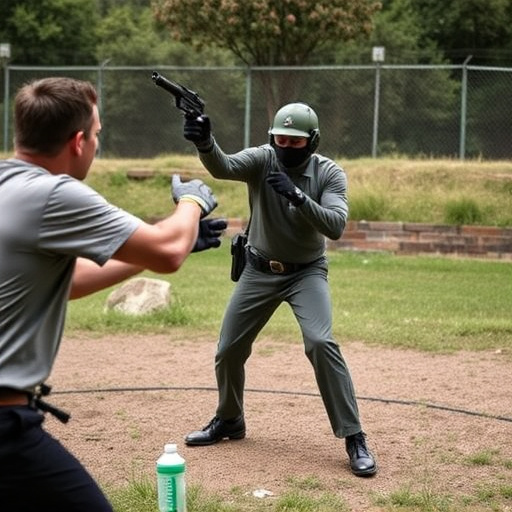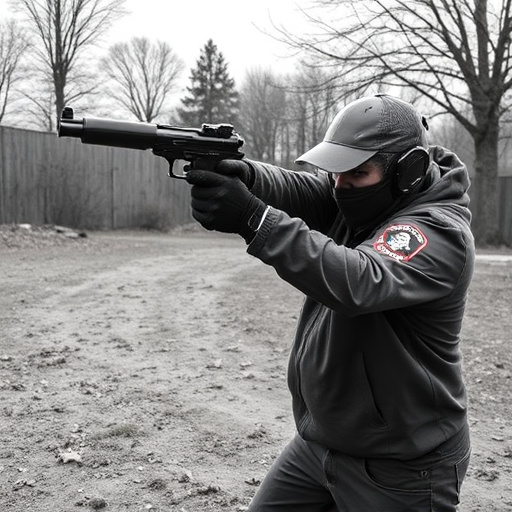Stun guns, while marketed as non-lethal, deliver electric pulses that can cause severe neurological side effects such as seizures and brain damage. Comprehensive training is vital for safe usage, covering device deployment, responsible use cases, and recognizing situations where stun guns might be inappropriate or harmful, especially in close quarters or against individuals with pre-existing medical conditions. The certification process involves rigorous steps prioritizing safety and proficiency, including understanding weapon mechanics, potential side effects, and practical assessments. Responsible usage measures protect public safety by mitigating adverse effects and emphasizing de-escalation techniques and immediate post-incident care.
“In today’s diverse and dynamic world, non-lethal weapon training is gaining prominence as a crucial aspect of personal safety. This comprehensive guide explores the ins and outs of non-lethal self-defense tools, with a specific focus on stun guns. From understanding their mechanisms to delving into the science behind their operation, we uncover both the benefits and potential risks. We also dissect the certification process, responsible usage guidelines, and safety measures, shedding light on the important considerations surrounding stun gun neurological side effects.”
- Understanding Non-Lethal Weapon Training: A Comprehensive Overview
- The Rise in Non-Lethal Self-Defense Tools: Stun Guns and More
- Exploring the Science Behind Stun Guns: How They Work
- Potential Neurological Side Effects of Stun Gun Use
- Certification Process for Non-Lethal Weapon Training
- Responsible Usage and Safety Measures for Non-Lethal Weapons
Understanding Non-Lethal Weapon Training: A Comprehensive Overview

Non-lethal weapon training involves learning and mastering tools designed to incapacitate or disrupt an individual’s physical capabilities without causing permanent harm or death. These weapons, such as stun guns, are increasingly popular among individuals seeking personal protection. However, it’s crucial to understand that despite their non-lethal label, they still carry potential risks, including neurological side effects. Research has shown that stun gun jolts can trigger complex physiological responses, affecting the cardiovascular and nervous systems.
Comprehensive training is essential to mitigate these risks and ensure safe usage. It involves learning not just the technical aspects of deploying the device but also understanding when and how to use it responsibly. This includes recognizing situations where a non-lethal weapon might be inappropriate or potentially harmful, especially in close quarters or against individuals with pre-existing medical conditions.
The Rise in Non-Lethal Self-Defense Tools: Stun Guns and More

In recent years, there’s been a notable surge in the popularity and adoption of non-lethal self-defense tools, with stun guns leading the charge. This shift can be attributed to evolving societal needs and a growing awareness of personal safety. Stun guns, also known as electronic control devices (ECDs), offer a non-violent alternative to traditional firearms, enabling individuals to defend themselves without causing permanent harm. Their effectiveness has been well-documented, with many users reporting successful deterrents against potential threats.
However, it’s crucial to highlight the potential neurological side effects associated with stun gun use, as these devices deliver powerful electrical shocks. While stun guns are designed to incapacitate rather than kill, they can still cause temporary physical and sensory disruptions. Users must be trained adequately to ensure responsible and safe deployment, minimizing both personal harm and legal repercussions. As non-lethal weapon training certification programs gain traction, individuals can gain the skills necessary to handle these tools effectively while understanding their limitations.
Exploring the Science Behind Stun Guns: How They Work

Stun guns, also known as electroshock weapons, operate by delivering a powerful electric current to disrupt an attacker’s neuromuscular system. When activated, the device fires two small probes into the target, which are connected to thin wires leading back to the stun gun. These probes penetrate the skin and transmit an electrical charge, causing involuntary muscle contractions and disorientation in the victim.
While stun guns are designed as non-lethal alternatives to traditional firearms, their impact on the human body is far from harmless. One of the primary concerns revolves around neurological side effects. The intense electric pulse can lead to temporary but severe symptoms such as seizures, dizziness, nausea, and even brain damage in some cases. Research suggests that repeated exposure to stun guns could have long-lasting effects on an individual’s nervous system, highlighting the importance of responsible use and training for those seeking certification in non-lethal weapon systems.
Potential Neurological Side Effects of Stun Gun Use

The use of stun guns, while often promoted as a non-lethal alternative to traditional firearms, is not without its potential risks. One significant concern revolves around neurological side effects that can arise from their usage. Stun guns deliver an electric shock designed to incapacitate a target temporarily, but these jolts can lead to adverse effects on the nervous system. Studies suggest that repeated exposure to stun gun shocks could result in short-term memory loss and cognitive impairments.
Additionally, individuals with pre-existing neurological conditions or those taking certain medications may be more susceptible to severe reactions. The electrical current can disrupt brain function, potentially causing dizziness, headaches, and even temporary paralysis. As such, proper training is crucial for individuals seeking stun gun certification, focusing not just on technique but also on understanding the potential risks and responsible use to mitigate these neurological side effects.
Certification Process for Non-Lethal Weapon Training

The Certification Process for Non-Lethal Weapon Training involves a series of rigorous steps designed to ensure safety and proficiency among users. It begins with a comprehensive understanding of the weapon’s mechanics, operation, and potential side effects, such as those related to stun guns and their neurological impacts. Trainees must demonstrate knowledge of safe handling practices, including proper storage, maintenance, and usage guidelines.
Practical assessments play a significant role in this process. Candidates are evaluated on their ability to deploy the non-lethal weapon effectively while minimizing risk. This includes scenarios designed to simulate real-world situations, where trainees must make split-second decisions under pressure. Additionally, understanding and mitigating potential neurological side effects of stun guns, such as temporary muscle paralysis or disorientation, is a critical component of certification, ensuring responsible usage in law enforcement and security contexts.
Responsible Usage and Safety Measures for Non-Lethal Weapons

The responsible usage and safety measures for non-lethal weapons, such as stun guns, are paramount to ensure public safety and prevent adverse effects. While these tools are designed to incapacitate individuals without causing permanent harm, they can still have significant neurological side effects if not handled correctly. Studies show that stun gun use can lead to temporary muscle paralysis, disorientation, and even cardiovascular issues in some cases. Therefore, comprehensive training is essential for individuals seeking non-lethal weapon certification.
Training programs must educate users on the proper application of force, including understanding the range of the device and safe distances. It should also cover de-escalation techniques to avoid unnecessary use and potential harm. Additionally, trainees should be instructed on immediate post-incident care, including how to administer first aid for any neurological symptoms that may arise following stun gun deployment. Regular refreshers and scenario-based training can help maintain proficiency and ensure users are prepared to handle any unforeseen circumstances while adhering to safety protocols.
In conclusion, non-lethal weapon training certification is a crucial step towards responsible usage and safety in handling stun guns and other self-defense tools. Understanding their mechanism, including potential neurological side effects like those associated with stun gun use, empowers individuals to make informed decisions. By navigating the certification process, users can ensure they are equipped with the knowledge and skills necessary to employ these devices effectively while mitigating risks. Responsible usage goes hand in hand with safety measures, fostering a culture of self-defense that prioritizes well-being over harm.
